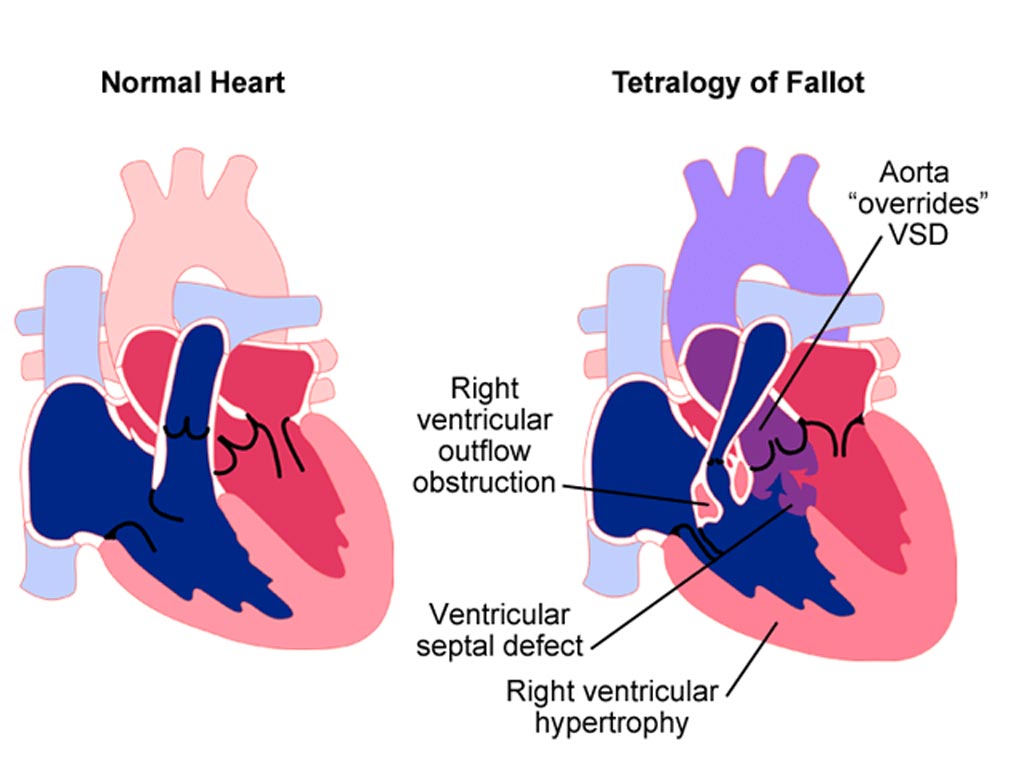Long-Term Survival in Repaired TOF is Excellent
|
By HospiMedica International staff writers Posted on 14 Jan 2019 |

Image: A new study shows Tetralogy of Fallot (TOF) repair has good long-term results (Photo courtesy of MedMovie).
A new study shows that the 25-year survival rate of surgical tetralogy of Fallot (TOF) patients is primarily influenced by the coexistence of an associated genetic condition.
Researchers at Emory University (Atlanta, GA, USA), the University of Minnesota (UMN; Minneapolis, USA), and other institutions conducted a retrospective cohort study involving 3,283 patients (56.4% men) enrolled in the Pediatric Cardiac Care Consortium (PCCC) between 1982 and 2003 and whom survived surgical repair of simple TOF. Main outcomes and measures were transplant-free survival during the early (less than six years) and late phase following surgical repair, adjusted for era and patient characteristics.
The results revealed that one-year survival rate following TOF repair was 98.6%, decreasing to 97.8% at five years; 97.1% at 10 years; 95.5% at 20 years; and 94.5% at 25 years, with an early steep mortality hazard increase peaking shortly after repair, followed by a late, gradual hazard increase. Increased mortality risks were found in non-valve-sparing operations and staged repair. Genetic abnormalities were associated with increased mortality risk in both early and late post-surgical phases. The study was published on December 19, 2018, in JAMA Cardiology.
“Long-term transplant-free survival beyond the first six years is influenced primarily by the coexistence of an associated genetic condition. Within the 25-year follow-up period, most deaths were associated with the underlying diagnosis of TOF and mediated by arrhythmias and congestive heart failure,” concluded lead author Clayton Smith, MD, of Emory University, and colleagues. “Staged repair and non–valve-sparing operations were negatively associated with survival in the early post-repair phase. These data are important for patients with repaired TOF and their caretakers, and may guide surgical strategies for optimizing the long-term outcomes of this population.”
TOF is a cyanotic congenital heart disease characterized by four main findings; pulmonary stenosis, a narrowing of the exit from the right ventricle; a ventricular septal defect; right ventricular hypertrophy; and an overriding aorta, which allows blood from both ventricles to enter the aorta. Symptoms include episodes of bluish color to the skin. Other symptoms may include a heart murmur, finger clubbing, and easy tiring upon breastfeeding. The cause is typically not known.
Related Links:
Emory University
University of Minnesota
Researchers at Emory University (Atlanta, GA, USA), the University of Minnesota (UMN; Minneapolis, USA), and other institutions conducted a retrospective cohort study involving 3,283 patients (56.4% men) enrolled in the Pediatric Cardiac Care Consortium (PCCC) between 1982 and 2003 and whom survived surgical repair of simple TOF. Main outcomes and measures were transplant-free survival during the early (less than six years) and late phase following surgical repair, adjusted for era and patient characteristics.
The results revealed that one-year survival rate following TOF repair was 98.6%, decreasing to 97.8% at five years; 97.1% at 10 years; 95.5% at 20 years; and 94.5% at 25 years, with an early steep mortality hazard increase peaking shortly after repair, followed by a late, gradual hazard increase. Increased mortality risks were found in non-valve-sparing operations and staged repair. Genetic abnormalities were associated with increased mortality risk in both early and late post-surgical phases. The study was published on December 19, 2018, in JAMA Cardiology.
“Long-term transplant-free survival beyond the first six years is influenced primarily by the coexistence of an associated genetic condition. Within the 25-year follow-up period, most deaths were associated with the underlying diagnosis of TOF and mediated by arrhythmias and congestive heart failure,” concluded lead author Clayton Smith, MD, of Emory University, and colleagues. “Staged repair and non–valve-sparing operations were negatively associated with survival in the early post-repair phase. These data are important for patients with repaired TOF and their caretakers, and may guide surgical strategies for optimizing the long-term outcomes of this population.”
TOF is a cyanotic congenital heart disease characterized by four main findings; pulmonary stenosis, a narrowing of the exit from the right ventricle; a ventricular septal defect; right ventricular hypertrophy; and an overriding aorta, which allows blood from both ventricles to enter the aorta. Symptoms include episodes of bluish color to the skin. Other symptoms may include a heart murmur, finger clubbing, and easy tiring upon breastfeeding. The cause is typically not known.
Related Links:
Emory University
University of Minnesota
Latest Surgical Techniques News
- Novel Glue Prevents Complications After Breast Cancer Surgery
- Breakthrough Brain Implant Enables Safer and More Precise Drug Delivery
- Bioadhesive Sponge Stops Uncontrolled Internal Bleeding During Surgery
- Revolutionary Nano Bone Material to Accelerate Surgery and Healing
- Superior Orthopedic Implants Combat Infections and Quicken Healing After Surgery
- Laser-Based Technique Eliminates Pancreatic Tumors While Protecting Healthy Tissue
- Surgical Treatment of Severe Carotid Artery Stenosis Benefits Blood-Brain Barrier
- Revolutionary Reusable Duodenoscope Introduces 68-Minute Sterilization
- World's First Transcatheter Smart Implant Monitors and Treats Congestion in Heart Failure
- Hybrid Endoscope Marks Breakthrough in Surgical Visualization
- Robot-Assisted Bronchoscope Diagnoses Tiniest and Hardest to Reach Lung Tumors
- Diamond-Titanium Device Paves Way for Smart Implants that Warn of Disease Progression
- 3D Printable Bio-Active Glass Could Serve as Bone Replacement Material
- Spider-Inspired Magnetic Soft Robots to Perform Minimally Invasive GI Tract Procedures
- Micro Imaging Device Paired with Endoscope Spots Cancers at Earlier Stage
- AI Spine Model Could Reduce Surgical Risks
Channels
Critical Care
view channel
Origami Robots to Deliver Medicine Less Invasively and More Effectively
Delivering medicine to ulcers or other internal sites often requires invasive procedures that can disrupt surrounding tissues and lengthen recovery times. Traditional magnetic actuators used in soft robotics... Read more
Improved Cough-Detection Technology Aids Health Monitoring
Coughing serves as an important biomarker for tracking a variety of conditions and can help monitor the progress of respiratory diseases or predict when someone’s asthma is being exacerbated.... Read morePatient Care
view channel
Revolutionary Automatic IV-Line Flushing Device to Enhance Infusion Care
More than 80% of in-hospital patients receive intravenous (IV) therapy. Every dose of IV medicine delivered in a small volume (<250 mL) infusion bag should be followed by subsequent flushing to ensure... Read more
VR Training Tool Combats Contamination of Portable Medical Equipment
Healthcare-associated infections (HAIs) impact one in every 31 patients, cause nearly 100,000 deaths each year, and cost USD 28.4 billion in direct medical expenses. Notably, up to 75% of these infections... Read more
Portable Biosensor Platform to Reduce Hospital-Acquired Infections
Approximately 4 million patients in the European Union acquire healthcare-associated infections (HAIs) or nosocomial infections each year, with around 37,000 deaths directly resulting from these infections,... Read moreFirst-Of-Its-Kind Portable Germicidal Light Technology Disinfects High-Touch Clinical Surfaces in Seconds
Reducing healthcare-acquired infections (HAIs) remains a pressing issue within global healthcare systems. In the United States alone, 1.7 million patients contract HAIs annually, leading to approximately... Read moreHealth IT
view channel
Printable Molecule-Selective Nanoparticles Enable Mass Production of Wearable Biosensors
The future of medicine is likely to focus on the personalization of healthcare—understanding exactly what an individual requires and delivering the appropriate combination of nutrients, metabolites, and... Read moreBusiness
view channel
Philips and Masimo Partner to Advance Patient Monitoring Measurement Technologies
Royal Philips (Amsterdam, Netherlands) and Masimo (Irvine, California, USA) have renewed their multi-year strategic collaboration, combining Philips’ expertise in patient monitoring with Masimo’s noninvasive... Read more
B. Braun Acquires Digital Microsurgery Company True Digital Surgery
The high-end microsurgery market in neurosurgery, spine, and ENT is undergoing a significant transformation. Traditional analog microscopes are giving way to digital exoscopes, which provide improved visualization,... Read more
CMEF 2025 to Promote Holistic and High-Quality Development of Medical and Health Industry
The 92nd China International Medical Equipment Fair (CMEF 2025) Autumn Exhibition is scheduled to be held from September 26 to 29 at the China Import and Export Fair Complex (Canton Fair Complex) in Guangzhou.... Read more













